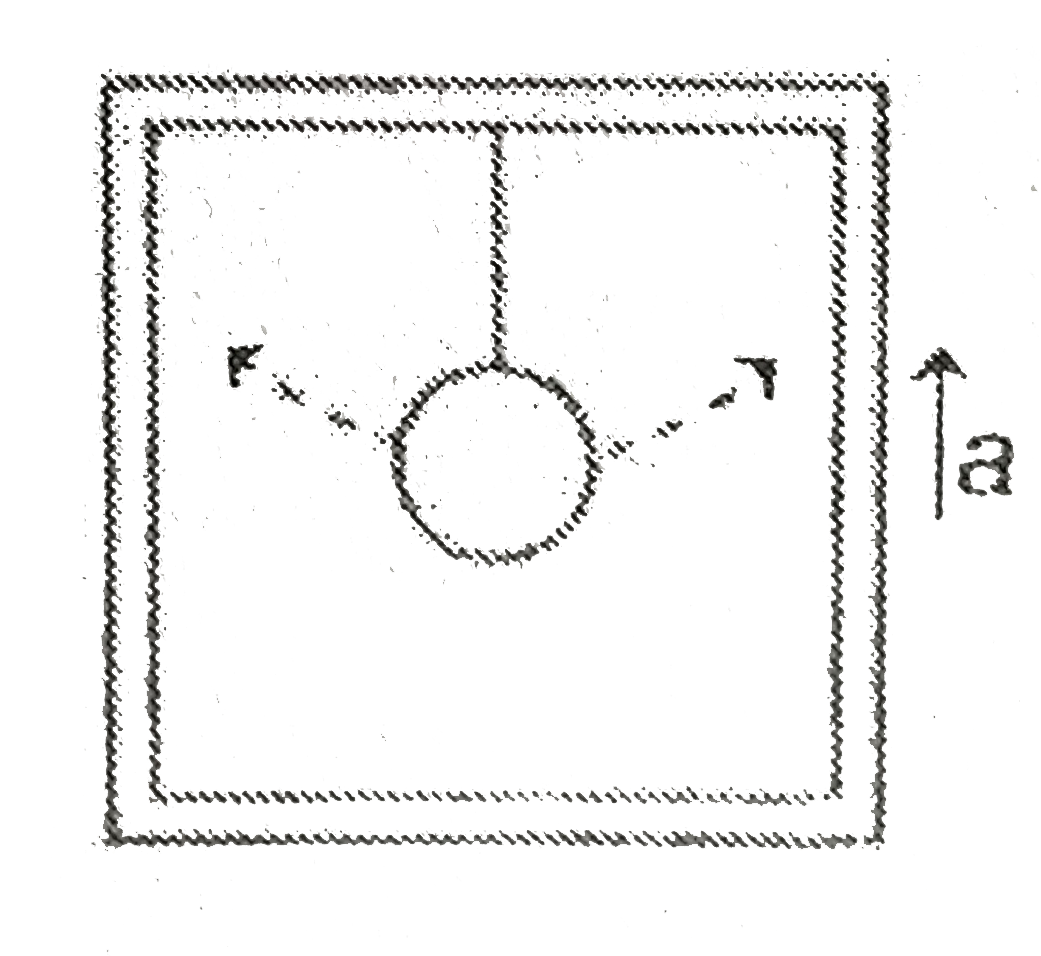A particle is thrown up inside a stationary lift of sufficient height. The time of flight is T. Now it is thrown again with same initial speed v0 with respect to lift. At the time of second throw, lift is moving up with speed v0 and uniform acceleration g upward (the acceleration due to gravity). The new time of flight is:
T4
T2
T
2T
The correct Answer is:B
To solve the problem, we need to analyze the motion of the particle in both scenarios: when the lift is stationary and when the lift is moving upward with a certain velocity and acceleration.
Step 1: Analyze the first case (Lift is stationary)
In the first scenario, the particle is thrown upwards with an initial speed v0 from a stationary lift. The time of flight T can be derived using the following kinematic equation:
s=ut+12at2
Where:
- s = displacement (which is 0, as the particle returns to the same height)
- u=v0 (initial velocity)
- a=−g (acceleration due to gravity, acting downwards)
- t=T (time of flight)
Substituting these values into the equation gives:
0=v0T−12gT2
Rearranging this, we find:
v0T=12gT2
Dividing both sides by T (assuming T≠0):
v0=12gT
From this, we can express T:
T=2v0g
Step 2: Analyze the second case (Lift is moving upward)
In the second scenario, the lift is moving upward with a speed v0 and has an upward acceleration of g. We need to find the new time of flight T′.
In this case, the effective acceleration acting on the particle (relative to the lift) is:
a′=−g−g=−2g
The kinematic equation remains the same:
s=ut+12a′t2
Where:
- s=0 (the particle returns to the same height)
- u=v0 (initial velocity)
- a′=−2g (effective acceleration)
Substituting these values gives:
0=v0T′+12(−2g)(T′)2
This simplifies to:
0=v0T′−g(T′)2
Rearranging gives:
g(T′)2=v0T′
Dividing both sides by T′ (assuming T′≠0):
gT′=v0
Thus, we can express T′:
T′=v0g
Step 3: Relate T′ to T
From our earlier result for T:
T=2v0g
Now, we can express T′ in terms of T:
T′=v0g=12(2v0g)=12T
Final Answer:
The new time of flight T′ is:
T′=T2
- s = displacement (which is 0, as the particle returns to the same height)
- u=v0 (initial velocity)
- a=−g (acceleration due to gravity, acting downwards)
- t=T (time of flight)
- s=0 (the particle returns to the same height)
- u=v0 (initial velocity)
- a′=−2g (effective acceleration)
Topper's Solved these Questions
- KINEMATICSBook:MOTIONChapter:KINEMATICSExercise:EXERCISE 2 OBJECTIVE PROBLEMS
Explore 75 Videos
- KINEMATICSBook:MOTIONChapter:KINEMATICSExercise:EXERCISE 2 OBJECTIVE PROBLEMS (Level-2)
Explore 26 Videos
- KINEMATICSBook:MOTIONChapter:KINEMATICSExercise:EXERCISE 4 PREVIOUS YEAR (LEVEL 2)
Explore 6 Videos
- HYDROSTATIC, FLUID MECHANICS & VISCOSITYBook:MOTIONChapter:HYDROSTATIC, FLUID MECHANICS & VISCOSITYExercise:EXERCISE -3 (SECTION-B) PREVIOUS YEAR PROBLEM
Explore 7 Videos
- KINETIC THEORY OF GASES Book:MOTIONChapter:KINETIC THEORY OF GASES Exercise:EXERCISE-3 SECTION-B
Explore 16 Videos
Similar Questions
A simple pendulum is hung in a stationary lift and its periodic time is T. What will be the effect on its periodic time T if
(i) the lift is moving up with a uniform velocity v,
(ii) the lift is moving up with a uniform acceleration a, and (iii) the lift is moving down with a uniform acceleration a?
View SolutionA pendulum is located inside lift.If initially time period is pendulum is T. Find its time period if lift accelerate upwards with acceleration g/2
View Solution
Knowledge Check
When a body is thrown up in a lift with a velocity u relative to the lift, the time of flight is found to be t. The acceleration with which the lift is moving up is
Au−gttBu+gttC2u−gttDut−2gWhen a body is thrown up in a lift with a velocity u relative to the lift, the time of flight is found to be t. The acceleration with which the lift is moving up is
Au-gttBu+gttC2u-gttD2u+gttA scientist measures the time period of a simple pendulum as T in a lift at rest. If the lift moves up with accelerationi as one fourth of the acceleratioin of gravity, the new time period is
 AT4B4TC2/sqrt(5)TD√52T
AT4B4TC2/sqrt(5)TD√52T
A simple pendulum is hung in a stationary lift and its periodic time is T. What will be the effect on its periodic time T if the lift goes up with uniform acceleration a ?
View SolutionA man measures the period of a simple pendulum inside a stationary lift and find it be T. If the lift accelerates downwards with an acceleration of g/3, then the period of the pendulum will be
View SolutionThe time period of a simple pendulum measured inside a stationary lift is found to be T . If the lift starts accelerating upwards with an acceleration g/3, the time period is
View SolutionThe time period of a simple pendulum is T remaining at rest inside a lift. Find the time period of pendulum when lift starts to move up with an acceleration of g/4
View SolutionA coin is dropped in a lift. It takes time t1 to reach the floor when lift is stationary. It takes time t2 when lift is moving up with costant acceleration. Then
View Solution

